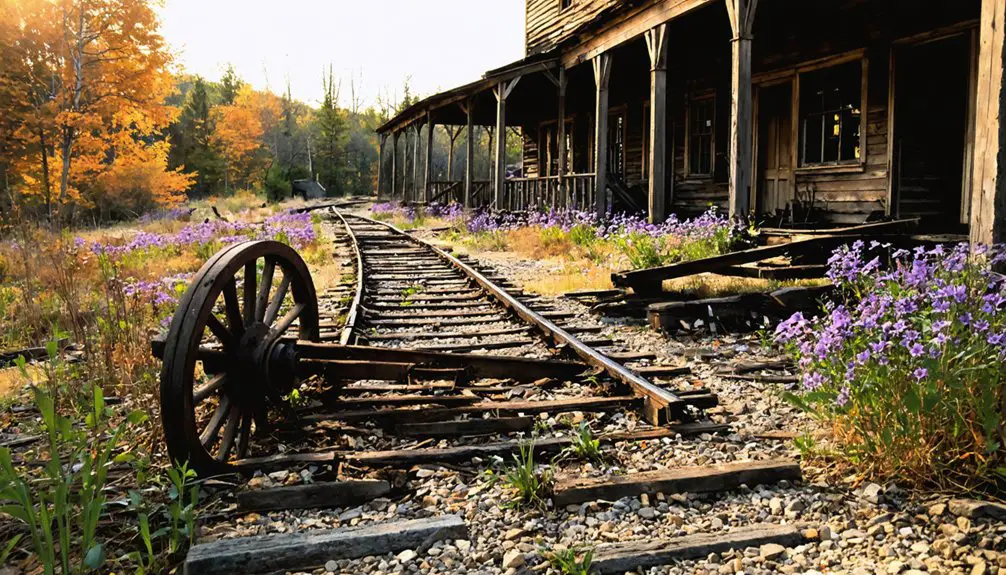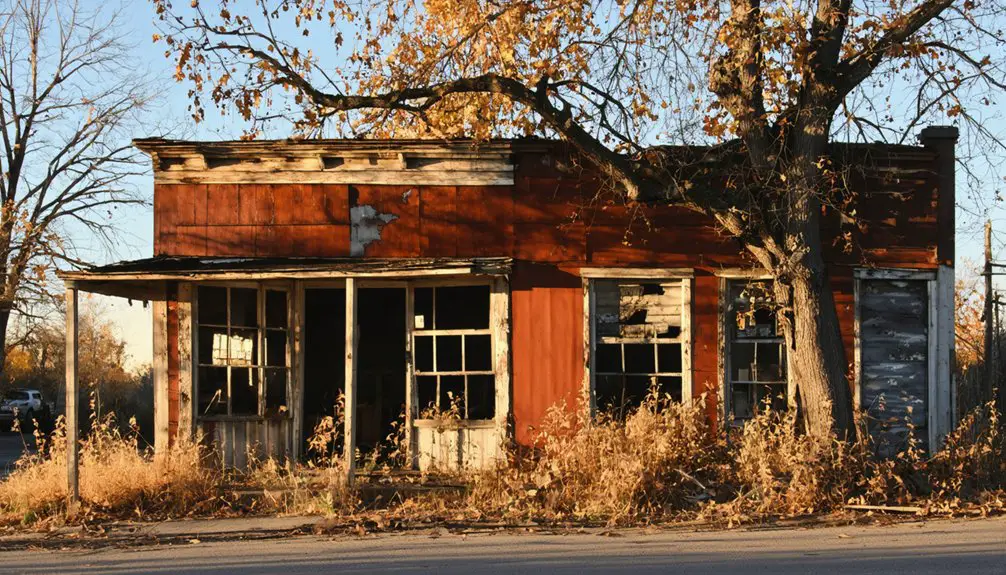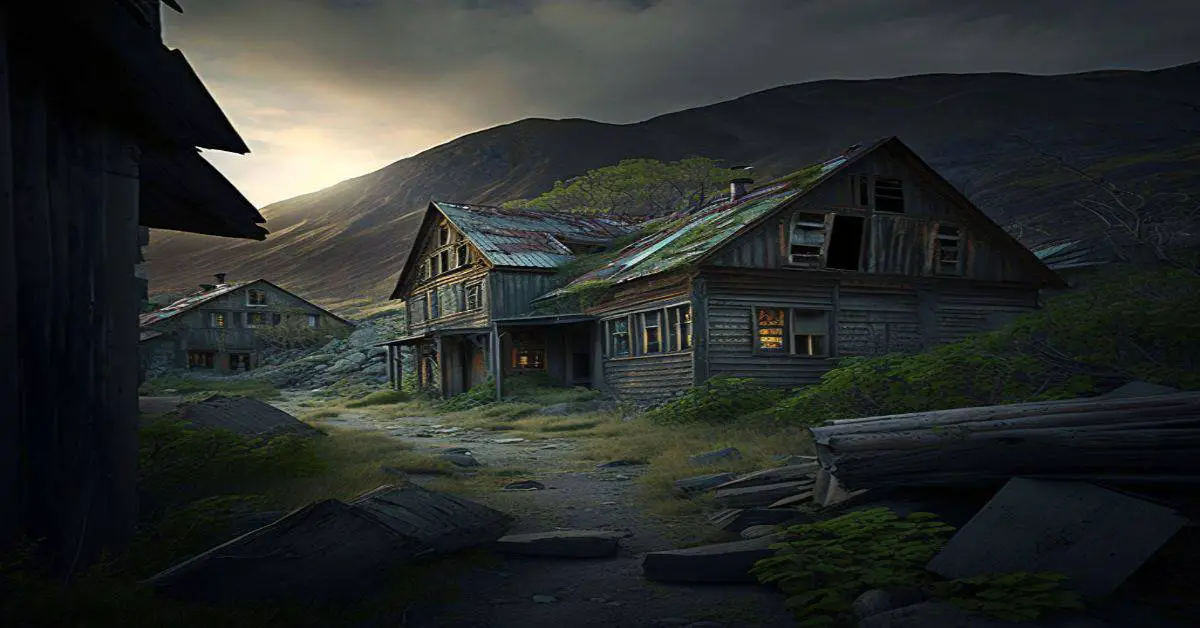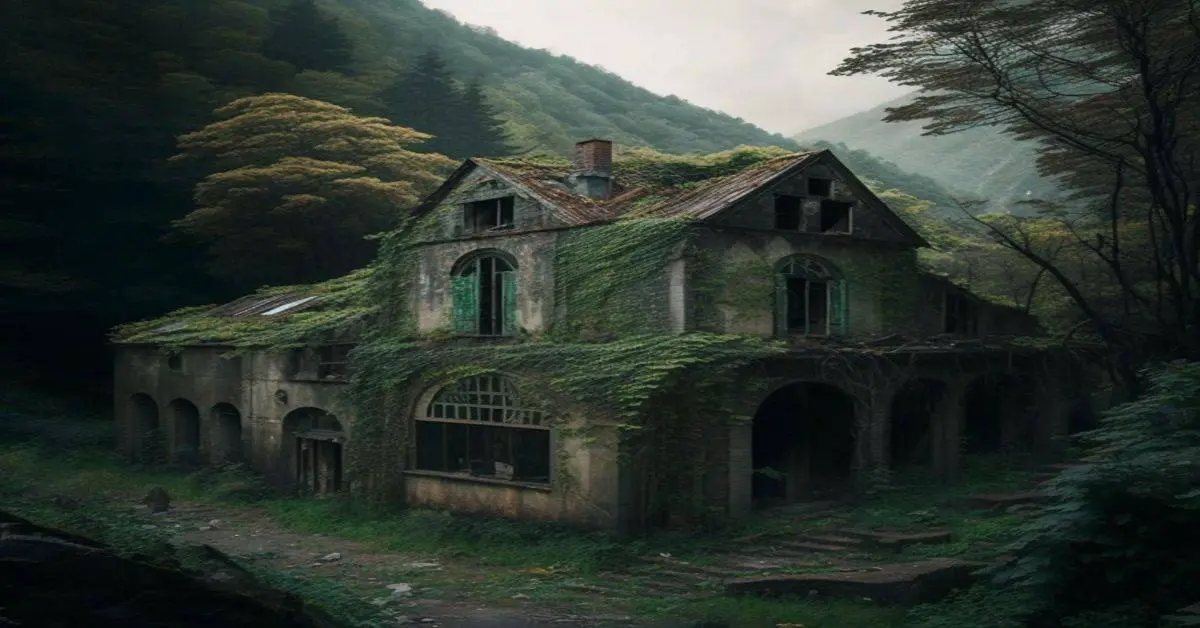You’ll find Metz, Michigan’s remains in Presque Isle County, where this once-prosperous lumber boomtown thrived with 600 families, three hotels, and multiple mills in the early 1900s. The devastating fire of October 15, 1908, changed everything – consuming 200,000 acres, claiming dozens of lives, and leaving 700 residents homeless. Today, only scattered ruins and a maintained cemetery mark where this Detroit & Mackinac Railroad stop stood, its story echoing warnings about single-industry dependence.
Key Takeaways
- Metz was a prosperous Michigan lumber town with 600 families, three hotels, multiple stores, and mills before its decline.
- The devastating 1908 fire destroyed over 200,000 acres, killed dozens, and left 700 residents homeless, marking the beginning of Metz’s downfall.
- Economic dependence on timber led to the town’s collapse when lumber resources were depleted and industry declined.
- Today, Metz exists only as a ghost town, with historical markers and a maintained cemetery preserving its memory.
- The Detroit & Mackinac Railway, once vital to Metz’s prosperity, now stands abandoned alongside the town’s few remaining structures.
The Birth of a Lumber Boomtown
During Michigan’s golden age of lumber in the mid-1800s, Metz emerged as a thriving boomtown in Presque Isle County, where vast pine forests provided the foundation for a robust timber-based economy.
You’ll find that lumber production shaped every aspect of life, as the town quickly grew to support three general stores, three hotels, multiple mills, and various essential services.
The community’s growth reflected the untamed spirit of the era, with about 600 families building their lives around the bustling timber trade. By the early 1900s, the population of Presque Isle County had swelled to over 11,000 residents.
While early logging relied on hand tools and horse power, with logs floating downstream to sawmills, the arrival of the Detroit and Mackinac Railway revolutionized transportation. Tragically, this same railway would later become a focal point when raging fires swept through the region’s pine forests in 1908.
This rail connection to major markets like Alpena and Cheboygan helped cement Metz’s position as a crucial hub in Michigan’s leading lumber industry.
Life Along the Detroit & Mackinac Railroad
If you’d lived in Metz during its heyday, you’d have encountered Detroit & Mackinac Railroad workers maintaining the crucial transportation artery that connected the town to major regional centers like Bay City and Alpena.
The railroad’s passenger service brought visitors and commerce to local establishments, including bustling saloons that sprang up near the tracks to serve both travelers and railroad employees. Forest products made up nearly half of the freight transported through the town in 1906, reflecting the area’s robust timber industry.
These saloons became social hubs where railroad workers, lumber workers, and townspeople gathered after their shifts, creating a distinctive culture that defined life along the Detroit & Mackinac line. The railroad’s transition to become first all-diesel railroad in America in 1946 marked a significant change in the community’s industrial landscape.
Railroad Workers’ Daily Life
Life along the Detroit & Mackinac Railroad centered on the bustling operational hub in Tawas City, where workers maintained locomotives, repaired rolling stock, and coordinated daily rail operations.
You’d find railroad routines structured around train schedules, with crews performing essential tasks like coupling cars, inspecting tracks, and operating switch points across 375 miles of line. Summer months brought additional responsibilities as crews managed the tourist traffic surge.
The worker camaraderie developed naturally in these close-knit railroad towns, where many employees lived in company-influenced housing. When the railroad moved its headquarters to Tawas City in 1902, it further strengthened the community’s railroad identity.
You’d share the challenges of working in Michigan’s harsh weather conditions, especially during winter track maintenance.
After 1946’s dieselization, you’d need to adapt your skills from steam to diesel engines, learning new mechanical systems while maintaining the same commitment to keeping freight moving efficiently through northern Michigan’s communities.
Passenger Service and Commerce
As passenger trains wound their way through Michigan’s northeastern corridor, the Detroit & Mackinac Railway served as an essential transportation artery, logging an impressive 7 million passenger-miles in 1925.
You’d have witnessed dramatic passenger dynamics as trains connected small towns like Metz to larger markets, until service ended in 1950. A tragic collision near Metz in 1907 between a passenger train and switch engine resulted in multiple injuries and one fatality. In 1908, the railway attempted a heroic rescue evacuation of Metz residents during a devastating wildfire.
The railway’s freight evolution tells a compelling story of growth, with revenue freight increasing from 81 million ton-miles in 1925 to 124 million by 1967.
You’d have seen timber, pulp, and agricultural products moving along the line, while local businesses thrived near stations.
Even after passenger service ceased, the railroad’s commercial impact continued, with portions operating under state ownership into the 1970s before being sold in 1992.
Saloon Culture Near Tracks
While steam engines rumbled past Metz’s busy streets, a vibrant saloon culture flourished alongside the Detroit & Mackinac Railway tracks, serving as essential social hubs for railroad workers and travelers alike.
You’d find these establishments bustling with activity during train arrivals and departures, as they provided more than just drinks – they offered food, lodging, and spaces for social interaction.
The saloons shaped the town’s economic and cultural fabric through transient culture, creating jobs in bartending, cooking, and maintenance. A tragic reminder of this railway culture came when the rescue train derailed, leading to devastating losses for the community.
Railroad crews often stopped between shifts, mixing with locals and sharing news and stories.
These saloon interactions weren’t just about leisure; they served as informal meeting places where labor issues and local politics were discussed, though occasionally, they’d become hotspots for disruptions that challenged town order.
The Fateful Day: October 15, 1908
You’ll find it hard to imagine the terror that struck Metz’s residents when fierce winds drove an unstoppable inferno toward their town on October 15, 1908.
The Detroit & Mackinac Railroad dispatched a rescue train to evacuate townspeople, but the intense heat warped the rails, causing a tragic derailment.
In that single disaster, the fire claimed dozens of lives, including nine children who perished in a gondola car, while leaving behind nothing but ashes and bones as grim evidence of their fate.
The devastating blaze swept 35 miles to Lake Huron, destroying everything in its path and leaving 700 residents without homes.
Deadly Winds Strike Town
On the morning of October 15, 1908, devastating winds swept through Michigan’s Presque Isle County, fueling a catastrophic fire that would forever change the town of Metz.
The perfect storm of environmental conditions had created a tinderbox. After a wet spring, the summer turned hot and dry, while early fall frosts further desiccated vegetation.
Wind patterns proved deadly as strong southerly breezes drove flames eastward, consuming up to 35 miles of dense pine forest by nightfall. At Hammond Bay, the winds shifted dramatically, pushing the inferno south toward Metz.
You’d have witnessed nature’s raw power as these conditions rendered fire prevention impossible. The village stood little chance as intense winds propelled flames through the community, destroying 134 homes and claiming 37 lives, including 16 people trapped on an evacuation train.
Flames Engulf Railroad Cars
Racing against approaching flames, a Detroit and Mackinac Railroad relief train departed Metz carrying approximately 40 residents, mostly women and children, along with their hastily-loaded belongings.
You’ll find this tragic tale of failed railroad safety and insufficient fire prevention measures ended at Nowicki’s siding, just two miles outside of town.
The intense inferno’s devastating impact:
- Burning wood piles along the tracks warped the rails and consumed railroad ties
- All five train cars derailed, trapping passengers in deadly flames and smoke
- At least 16 people perished, including engineer William Foster and conductor John Kinville
- The trapped refugees in open-top coal gondolas faced the most horrific conditions
This devastating incident represents the single greatest loss of life during the Metz Fire, forever changing the region’s history.
The Great Fire’s Devastating Path

The devastating Great Fire of 1908 began its destructive path through Michigan’s Presque Isle County on October 15, igniting in the dense pine forests west of Millersburg.
Historical narratives describe how strong winds and dry conditions fueled the fire’s rapid advance toward Metz, creating a fire ecology nightmare as flames consumed everything in their path.
You’ll find the fire’s reach was staggering – it jumped across Grand Lake and didn’t stop until hitting Lake Huron’s shore.
The inferno burned through more than 200,000 acres in Presque Isle County alone, surrounding Metz on all sides.
The village stood little chance as the flames approached, destroying hundreds of homes and farms.
Only a few structures, including the town’s flagpole, survived the catastrophic blaze.
Tales of Survival and Loss
Living through Metz’s devastating fire marked only the beginning of survivors’ hardships.
You’ll find survivor stories filled with tales of displacement, resource scarcity, and the struggle against Michigan’s harsh weather conditions. The community’s resilience shone through their collective response to tragedy, as neighboring towns provided essential aid to those who’d lost everything.
The survivors faced four vital challenges:
In the wake of catastrophe, four core trials tested Metz’s survivors as they fought to rebuild their shattered world.
- Finding shelter in makeshift camps or nearby communities
- Dealing with limited food and water supplies
- Coping with emotional trauma and loss of generational homes
- Rebuilding lives with drastically reduced economic opportunities
Despite these overwhelming obstacles, Metz’s close-knit community demonstrated remarkable strength through mutual aid networks and shared resources.
Though many eventually had to leave their beloved town behind.
Relief Efforts and Community Response

You’ll find that relief efforts after the Metz fire showcased remarkable community mobilization, with the Red Cross and Detroit & Mackinac Railroad coordinating the construction of 165 emergency shacks for displaced families.
The 14-by-16-foot relief structures, though cramped, provided critical shelter through the harsh winter of 1908-09, with only two original shacks still standing today.
Support poured in from across Michigan, including clothing donations from wealthy Grosse Pointe residents and a special rescue train that evacuated 40 mothers and children from the disaster zone.
Community Aid Mobilization
When disaster struck Metz in 1908, community aid mobilization emerged through several critical channels, with the Detroit & Mackinac Railroad leading initial rescue efforts.
Despite limited disaster preparedness of the era, the regional response demonstrated remarkable community resilience through coordinated support networks.
Key aspects of the mobilization included:
- Railroad deployment of a special rescue train targeting evacuation of mothers and children
- Regional coordination between nearby towns and agencies to provide temporary shelter and supplies
- Support from volunteer fire companies and relief groups providing essential aid to 700 homeless residents
- Long-term community rebuilding efforts by survivors and their descendants
You’ll find evidence of this historical response preserved at the Metz Fire Trailside Historical Park, where the derailment site commemorates both the tragedy and the determined relief efforts that followed.
Sheltering Winter Survivors
The immediate aftermath of the 1908 Metz Fire brought unprecedented challenges as hundreds of displaced residents faced the harsh northern Michigan winter.
Local authorities quickly implemented shelter strategies, converting public buildings and community halls into emergency housing while expediting the delivery of essential supplies.
Winter resilience emerged through coordinated community efforts. You’ll find that railway lines, despite fire damage, became vital lifelines for delivering warm clothing, blankets, and non-perishable food.
Local churches and social groups transformed into resource centers, where survivors gathered to share meals and pool resources. Medical teams worked diligently in these shelters, treating burns while preparing for cold-weather illnesses.
The community’s swift response included establishing sanitation protocols and implementing heating solutions, forming a vital foundation for survival through the bitter months ahead.
The Economic Aftermath
Much like many Michigan ghost towns, Metz’s economic decline stemmed directly from its heavy dependence on resource extraction industries.
When local resources depleted and industries collapsed, economic policies failed to create sustainable alternatives, leading to widespread job migration.
You’ll find the devastating economic aftermath reflected in these key impacts:
- Manufacturing incentives like MEGA tax credits backfired, correlating with a loss of 95 jobs per $1 million in credits.
- Businesses shuttered as consumer confidence plummeted, destroying the local tax base.
- Schools and post offices closed due to population exodus and declining revenues.
- Tourism couldn’t compensate for lost industrial jobs, leaving the economy without a safety net.
The town’s inability to diversify beyond resource extraction sealed its fate, mirroring the broader struggles of Michigan’s rural communities.
From Thriving Village to Abandoned Ruins
Prior to its tragic transformation into a ghost town, Metz stood as a bustling lumber village until October 15, 1908, when a devastating fire forever altered its destiny.
The inferno’s savage destruction of homes, businesses, and essential infrastructure left the community struggling to survive. Despite initial community rebuilding efforts, many residents never returned after evacuating, and those who lost family members in the train disaster carried deep emotional scars.
You’ll find the village’s decline was swift – harsh winters and limited investment prevented meaningful recovery.
Today, historical preservation efforts maintain memories of Metz through markers and memorials, while physical remnants like warped railroad ties and building foundations serve as silent witnesses to the village’s former significance.
Nature has slowly reclaimed the land where this once-thriving community stood.
Preserving Metz’s Historical Legacy
While physical traces of Metz continue to fade, dedicated preservation efforts guarantee its story endures for future generations.
Preservation challenges, including limited funding and remote location, haven’t deterred community involvement in protecting this historical treasure. You’ll find local historical societies and volunteers working tirelessly to document and maintain the site’s remaining structures and artifacts.
Key preservation initiatives include:
- Archaeological surveys recovering artifacts that reveal daily life
- Cemetery maintenance honoring former residents
- Educational programs featuring virtual tours and field trips
- Collaboration with descendants who contribute oral histories
You can explore Metz’s legacy through informational signage, online archives, and community events that keep the town’s memory alive.
Local ranchers and volunteer groups maintain site access while protecting its historical integrity.
Learning From Michigan’s Lost Communities
As towns like Metz fade into history, they offer essential lessons about sustainable community development in Michigan.
You’ll find that single-industry dependence, whether on mining or logging, created vulnerable economies that couldn’t withstand market shifts or resource depletion. These boom-and-bust cycles highlight the critical need for economic diversification and community resilience in rural areas.
Today’s communities can learn from studying Michigan’s ghost towns, where rapid population growth followed by swift decline left only remnants of once-thriving societies.
You’ll see this pattern repeated across the Upper Peninsula, particularly in mining regions like the Keweenaw Peninsula. By understanding these historical examples, modern planners can work toward economic sustainability through balanced development, diverse industry bases, and adaptable infrastructure – protecting against the fate that befell communities like Metz.
Frequently Asked Questions
Are There Any Remaining Descendants of Metz Fire Survivors Living Nearby Today?
You’ll find some descendant community members still living in the region, though exact numbers aren’t documented. Local survivor stories persist through families, but thorough records tracking direct descendants remain limited.
What Native Plants and Wildlife Returned to Metz After the Fire?
Nature finds a way – you’d see native wildlife like deer, woodpeckers, and squirrels return alongside pine seedlings, cedar, goldenrod, and maple saplings during the ecological recovery, creating vibrant new habitats.
Did Any Original Artifacts From Pre-Fire Metz Survive to Modern Times?
You won’t find verified pre-fire artifacts today, as intense heat destroyed most items and limited preservation efforts followed. No confirmed discoveries exist in museums or collections from before the 1908 disaster.
Were There Supernatural Stories or Legends Associated With the Metz Ghost Town?
You won’t find documented supernatural sightings in this case – unlike other Michigan ghost towns with rich paranormal folklore, local legends about Metz are strikingly absent from historical and paranormal records.
How Did Neighboring Towns’ Populations Change After Absorbing Metz Refugees?
You’ll find neighboring towns experienced modest population shifts as they absorbed refugees, though long-term integration remained limited. Most communities saw temporary increases without substantial sustained growth due to broader regional economic decline.
References
- https://northernmichiganhistory.com/the-metz-fire/
- https://kids.kiddle.co/List_of_ghost_towns_in_Michigan
- https://www.restless-viking.com/2020/07/09/freda-ruins/
- https://www.geocaching.com/geocache/GCJRA9
- https://99wfmk.com/metz-fire-2019/
- https://www.thealpenanews.com/news/local-news/2018/10/the-day-presque-isle-county-burned/
- https://mff.forest.mtu.edu/PDF/1-TreeBasics/3-History.pdf
- https://www.restless-viking.com/2022/11/15/the-metz-fire-a-michigan-tragedy/
- https://pichmuseum.org/the-metz-fire/
- https://en.wikipedia.org/wiki/Detroit_and_Mackinac_Railway


